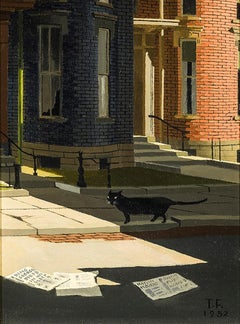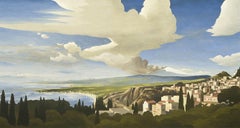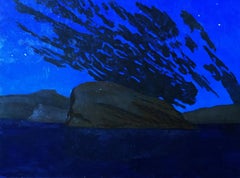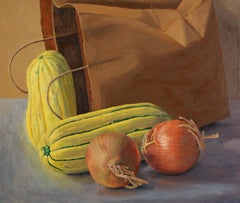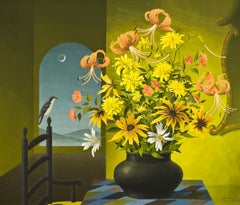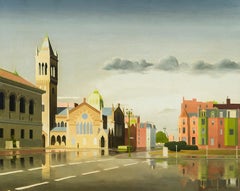Thomas Fransioli Paintings
to
1
1
Overall Width
to
Overall Height
to
2
1
1
1
1
1
1
1
1
1
1
1
1
2
2
2
2
2
781
713
712
689
2
Artist: Thomas Fransioli
Street Scene: "King George Dies"
By Thomas Fransioli
Located in New York, NY
Fransioli was born in Seattle, Washington, and received a degree in architecture from the University of Pennsylvania in 1930. He worked with John Russell Pope on plans for the exhibition galleries at the National Gallery of Art in Washington, D.C., which he pinpointed as the beginning of his interest in painting. World War II interrupted a promising career in architecture. Fransioli served in the Pacific Theatre from 1943 until 1946, and was among the first American soldiers to survey Hiroshima after the atomic bomb’s detonation in August 1945. He returned to civilian life and took up painting, basing himself in Boston, but working up and down the eastern seaboard.
Thomas Fransioli’s cityscapes are crisp and tidy. Buildings stand in bold outline, their forms squarely defined by stark light and long shadows. Saturated color permeates every corner of his canvases, from vibrant oranges and greens to smoky terra cottas and granites. Even the trees that line Fransioli’s streets, parks, and squares are sharp and angular, exactly like those in an architect’s elevation rendering. But Fransioli’s cities often lack one critical feature: people. His streets are largely deserted, save for parked cars and an occasional black cat scurrying across the pavement. People make rare appearances in Fransioli’s compositions, and never does the entropy of a crowd overwhelm their prevailing sense of order and precision. People are implied in a Fransioli painting, but their physical presence would detract from the scene’s bleak and surreal beauty.
Magic Realism neatly characterizes Fransioli’s artistic viewpoint. The term was first broadly applied to contemporary American art in the 1943 Museum of Modern Art exhibition, American Realists and Magic Realists. As exhibition curator Dorothy Miller noted in her foreword to the catalogue, Magic Realism was a “widespread but not yet generally recognized trend in contemporary American art…. It is limited, in the main, to pictures of sharp focus and precise representation, whether the subject has been observed in the outer world—realism, or contrived by the imagination—magic realism.” In his introductory essay, Lincoln Kirstein took the concept a step further: “Magic realists try to convince us that extraordinary things are possible simply by painting them as if they existed.”
This is Fransioli, in a nutshell. His cityscapes exist in time and space, but certainly not in the manner in which he portrays them.
Fransioli—and other Magic Realists of his time—was also the heir to Precisionism, spawned from Cubism and Futurism after the Great War and popularized in the 1920s and early 1930s. While Fransioli may not have aspired to celebrate the Machine Age, heavy industry, and skyscrapers in the same manner as Charles Sheeler, his compositions tap into the same rigid gridwork of the urban landscape that was first codified by the Precisionists.
During the 1950s, Fransioli was represented by the progressive Margaret Brown...
Category
20th Century American Realist Thomas Fransioli Paintings
Materials
Canvas, Oil
Mt. Etna from Taormina
By Thomas Fransioli
Located in New York, NY
Thomas Fransioli, born in 1906 in Seattle, Washington, trained as an architect at the University of Pennsylvania. He worked as an architect before his service in World War II. Largel...
Category
20th Century American Realist Thomas Fransioli Paintings
Materials
Canvas, Oil
Related Items
Norway III, dark blues and blacks, night sky
By Gregory Frux
Located in Brooklyn, NY
Dr. Rowland S. Russell PhD. writes about his experience directly witnessing Greg's practice as a “plein air” artist:
Whether he’s portraying quiet scenes from Brooklyn’s Prospect Park or the Botanical Gardens, intriguing remnants of New York’s varied industry (grain silos...
Category
2010s American Realist Thomas Fransioli Paintings
Materials
Canvas, Oil
Squash and Onions, warm earth tones food realistic still life
By Douglas Newton
Located in Brooklyn, NY
Doug Newton’s hyper-real paintings observe reality, explore translucency, reflections and luminosity, and dazzle the viewer with all the ways light can transform our perceptions. His subject matter concentrates on still lives of food, toys, candy and household objects.
In addition to many group shows across the country, Mr. Newton’s show, “HARD CANDY and other confections” represents his fifth solo exhibition. His paintings have been collected in numerous private collections.
Mr. Newton resides in Fort Greene, Brooklyn, NY.
Dr. Sonia Coman writes in her essay, Doug Newton’s hard candy: the confection of painting
Doug Newton’s paintings are about… painting.
The hyperrealist technique of trompe l’oeil or “trick the eye” is knowingly playful. It simultaneously calls attention to the illusion of a different material—for example, translucent candy wrappers—and the reality of the layers of paint, masterfully applied to the canvas. In that, Newton’s paintings pay homage to an esteemed series of trompe l’oeil masters, from Inquisition-era Spanish painter Francisco de Zurbarán to Gilded-Age American painter William Michael Harnett...
Category
2010s American Realist Thomas Fransioli Paintings
Materials
Oil, Canvas
$1,400
H 20 in W 24 in D 1.5 in
Ocean Beach, 2023
By Willard Dixon
Located in Burlingame, CA
Oil painting by Willard Dixon featuring figures enjoying a day at Ocean Beach in San Francisco. Willard Dixon, who is one of the finest American contempora...
Category
21st Century and Contemporary American Realist Thomas Fransioli Paintings
Materials
Canvas, Oil
Approach to Lee's Ferry
By Kim Whitesides
Located in Salt Lake City, UT
"Approach to Lee's Ferry" by Kim Whitesides, oil on canvas, 18 X 22 inches (Framed size: 21.5 x 25.5 inches)
Whitesides made an impact in the art community at a very young age. While working as an illustrator in New York City from the late 60s through the mid 80s, his paintings appeared in many publications, including Time Magazine, Rolling Stone and Playboy. He received numerous awards from The Art Directors Club of New York and The Society of Illustrators. It was at this time that Whitesides began a period of bold work with the airbrush that emphasized the simplified spaces and clean lines of art deco and art moderne, for which he gained a national reputation.
A native Utahn, Whitesides believes art is a language and an opportunity for his vision to inspire others. He continues to grow as an artist, as his art is constantly opening doors on new vistas...
Category
21st Century and Contemporary American Realist Thomas Fransioli Paintings
Materials
Canvas, Oil
Reverie: Morning
By Brooks Anderson
Located in Burlingame, CA
Ethereal landscape with water celebrating morning light. Oil on canvas is 30 x 40 inches, and it is meticulously painted by Brooks Anderson. Signed, ti...
Category
21st Century and Contemporary American Realist Thomas Fransioli Paintings
Materials
Canvas, Oil
'The Artist's Garden', Munich Academy, Art Institute of Chicago, PAFA, Corcoran
By Julius Moessel
Located in Santa Cruz, CA
'The Artist's Garden' by Julius Moessel, 1943.
Munich Academy, Art Institute of Chicago, Philadelphia Academy of Fine Arts, Corcoran
-----
Signed lower left 'Moessel' for Julius Moe...
Category
1940s American Realist Thomas Fransioli Paintings
Materials
Canvas, Oil
$5,000
H 30 in W 26 in D 0.75 in
"Nocturnal Lotus" SALE oil on canvas, 1981
By Lowell Nesbitt
Located in Southampton, NY
Lowell Nesbitt's paintings are in most major museum collections. He is the artist that NASA selected to commemorate the Apollo Moon missions over 50 years ago.
In the 1950s he dabb...
Category
1980s American Realist Thomas Fransioli Paintings
Materials
Canvas, Oil
Outlaw Mesa Shadows
Located in Salt Lake City, UT
Outlaw Mesa Shadows, oil on canvas 17 x 30 inches (Framed size: 18 x 31 inches), $2,900
Leslie Thomas returned to painting after working 20 years as a computer engineer. She has since studied painting under Mark Knudsen...
Category
2010s American Realist Thomas Fransioli Paintings
Materials
Canvas, Oil
Stillwater
By Brooks Anderson
Located in Burlingame, CA
'Stillwater' - oil on canvas is 12 x 36 inches, meticulously painted by Brooks Anderson. Canvas edges are painted dark in artist's signature style. Lovely to behold from every angle....
Category
21st Century and Contemporary American Realist Thomas Fransioli Paintings
Materials
Canvas, Oil
Gem II, mysterious window image, dark colors
By Gregory Frux
Located in Brooklyn, NY
Mansard Window, Oil on canvas, cityscape
Sixth Avenue, Park Slope, Brooklyn
Dr. Rowland S. Russell PhD. writes about his experience directly witnessing Greg's practice as a “plein a...
Category
2010s American Realist Thomas Fransioli Paintings
Materials
Canvas, Oil
"Misty City", Oil Painting
By Christopher Clark
Located in Denver, CO
Christopher Clark's (US based) "Misty City" is an original, handmade oil painting that depicts orange and green hued clouds arching over a water and city lights
Bio/artist statement:
Christopher has been an artist since early childhood, when he would watch Bob Ross on PBS and mimic the famed oil painter’s art with crayons. He considers himself a self-educated artist, with his studies ranging from personal training with contemporary masters, to classical academic art technique, with much inspiration from 19th Century art and the Impressionist Movement. Christopher lived in Italy for a time, immersing himself in Italian culture and art, which continues to influence his painting. His fan base has grown considerably since his return to the US, gaining the attention of Lucasfilm and Marvel Fine Art, which both signed him as an officially licensed artist in 2016. Other clients include George Lucas, Major League Baseball, Louisville Slugger...
Category
2010s American Realist Thomas Fransioli Paintings
Materials
Canvas, Oil, Panel
Humboldt County no. 4
By Brooks Anderson
Located in Burlingame, CA
Humboldt County ocean beach scene - oil on canvas is 24 x 36 inches, meticulously painted by Brooks Anderson. Canvas edges are painted dark in artist's signature style. Lovely to beh...
Category
21st Century and Contemporary American Realist Thomas Fransioli Paintings
Materials
Canvas, Oil
Previously Available Items
Still Life of Flowers
By Thomas Fransioli
Located in New York, NY
Signed and dated (at lower right): FRANSIOLI 1959
Category
Mid-19th Century American Realist Thomas Fransioli Paintings
Materials
Canvas, Oil
Copley Square, Boston
By Thomas Fransioli
Located in New York, NY
Thomas Fransioli’s cityscapes are crisp and tidy. Buildings stand in bold outline, trees are sharp, and saturated color permeates the scene. But Fransioli’s cities often lack one critical feature: people. His streets are largely deserted, save for the rare appearance of figure and the occasional black cat scurrying across pavement. Instead, humanity is implied. Magic Realism neatly characterizes Fransioli’s viewpoint. First applied to American art in the 1943 MoMA exhibition “American Realists and Magic Realists...
Category
20th Century American Realist Thomas Fransioli Paintings
Materials
Canvas, Oil
View from The Hill, Castine
By Thomas Fransioli
Located in New York, NY
Signed and dated (at lower right): T.F./1946
Category
1940s American Realist Thomas Fransioli Paintings
Materials
Canvas, Oil
Street Scene in Bar-le-Duc
By Thomas Fransioli
Located in New York, NY
Signed and dated (at lower right): TF/1952
Category
1950s American Realist Thomas Fransioli Paintings
Materials
Canvas, Oil
Thomas Fransioli paintings for sale on 1stDibs.
Find a wide variety of authentic Thomas Fransioli paintings available for sale on 1stDibs. You can also browse by medium to find art by Thomas Fransioli in canvas, fabric, oil paint and more. Not every interior allows for large Thomas Fransioli paintings, so small editions measuring 7 inches across are available. Customers who are interested in this artist might also find the work of Paul Zimmerman, John McCormick, and Michael Kotasek. Thomas Fransioli paintings prices can differ depending upon medium, time period and other attributes. On 1stDibs, the price for these items starts at $14,000 and tops out at $55,000, while the average work can sell for $28,000.
